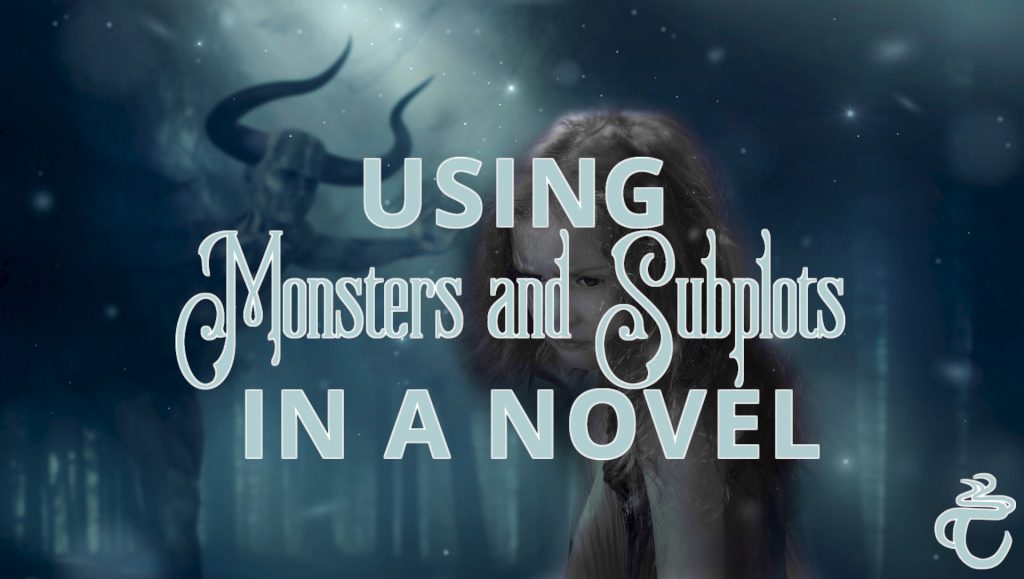It’s no secret that good fantasy novels keep readers on the edge of their seats with action and conflict. But as you’re writing fantasy, how do you know if you have a good balance of monsters and subplots in a novel?
In my latest WIP, I’ve used the Hero’s Journey to plot out the story. First, I broke down the Hero’s Journey scene-by-scene, then filled in the gaps for what needed to happen. This method has kept the action high, ensured conflict in each scene, and allowed me to see the story’s “big picture.”
So what’s taking so long to finish the draft?
You must be wondering, especially if I speak so highly of this plotting method. I have three excuses—er, reasons:
Well, in addition to being the World’s Slowest Writer(TM), I am up against a big story. I’ve already clocked in over 100,000 words, and I’m still not finished. If my scene count is correct, I’m going to add another 24,000 words to finish the first draft. Add to that how almost every scene has run long. During the editing process, I expect to add more words since I usually write pretty lean, so this project is massive. And it’s only Book 1 of what I expect to be a trilogy. Yikes.
Finally, I kept plodding away despite the queasy feeling that something was missing. As a writer, I’ve learned to listen to that feeling, even if I can’t pinpoint the exact cause right away.
In the last few months, I finished reading the ACOTAR series. To this writer, it was apparent when the characters went from one quest to the next. This certainly didn’t make the series any less enjoyable, mind you. It’s just that I noticed the pattern of the Hero’s Journey as I read.
Recognizing Patterns
As a writer and an engineer, I tend to notice plot devices in stories. Repetition of certain elements and patterns—they exist in stories just as they do in math. I don’t read mysteries anymore because the villain rarely surprises me. The reveal might be a good one, but I almost always knew who did it long before getting to that point in the story. How do I know? Two reasons:
- Mysteries require the introduction of the villain in the first third of the book.
- A storyteller shouldn’t draw attention to something more than once unless it’s important.
Sorry if I accidentally ruined mysteries for you, too.
Honestly, these facts are the reason Chamber of Secrets is my least favorite Harry Potter book. I figured the monster out long before Harry, so it didn’t leave me reeling like the other books.
But all this pattern recognition did show me that my WIP lacked monsters.
Wait, you don’t have monsters in your fantasy novel?
It sounds ridiculous to you, too, doesn’t it? What fantasy story fails to introduce fantastical creatures? Well, mine did up until about two months ago. Now that I realize it, Dark Empire also lacks monsters, though the overarching plot definitely contains a few.
So I went on a personal quest to find some monsters for my story.
How to Add Monsters and Subplots in a Novel
Let’s start with subplots. A good novel has 3 to 5 ongoing subplots to keep the main premise moving. So I started by counting up the different threads woven into the story. I definitely have no shortage of subplots, but if you’re struggling, here’s a starter list:
- Why is the villain a bad guy?
- How’s the romance going?
- What strains relationships between the characters?
- What do the main characters want, and how is their adventure keeping them from attaining it?
Once you have different threads for your story, it’s easier to break up where they occur in the main plot. But this didn’t solve my real problem, which is no monsters.
Off I went to do more research. This time, I targeted the setting of my novel: a fantastical Renaissance-era Russia and India. What kind of monsters do those regions and eras of literature contain?
First, I focused on India, only to find that most monsters aren’t inherently evil unless they are also demons. Taking an exotic creature and turning it evil just because of how it looks doesn’t suit my moral compass. It’s not like they could help being born or created that way.
No, they need motivation—just like any non-monster character—for their actions and choices. The ACOTAR series in my opinion handled this quite well, even if we didn’t know the monsters’ motivations immediately.
Plenty of demons in Hindu mythology are also fairly human-like. But they also all seem to exist only for a particular god to defeat them in a specific way. I abandoned that line of exploration pretty quickly.
Then I found the fantastical creatures European literature traced back to the Indian subcontinent, and I found suggestions that sparked my imagination.
Here again, in my story, the monsters themselves aren’t inherently evil. As sentient creatures, they have reasons for acting as they do. Perhaps they are minions of someone worse. Maybe they suffered injustice and seek vengeance. Possibly their moral compass points differently. You’ll have to read the book to find out.
Treating monsters just like any other character creates a richer fantasy world. Build subplots around monsters—especially if they carry across the series (again, ACOTAR managed this beautifully). Properly motivated monsters and subplots in a novel are critical to a well-crafted fantasy.
Armed with this knowledge, I added certain scenes and discovered new connections to bring the story together. That niggling worry that something vital was wrong? Gone. Whew! Now, onward to finish this WIP.

